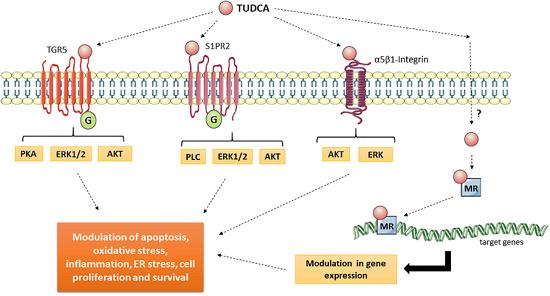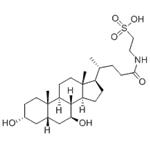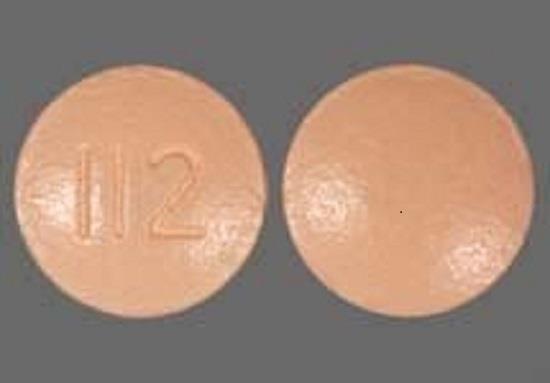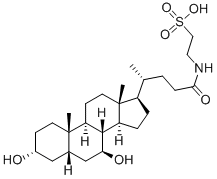Tauroursodeoxycholic Acid: Exploring its Vital Role in Various Biological Processes
May 29,2023
General Description
Tauroursodeoxycholic acid (TUDCA) is a bile acid derived from ursodeoxycholic acid (UDCA). It is naturally produced in the body through a series of enzymatic reactions in the liver, which convert cholesterol into primary bile acids including cholic acid and chenodeoxycholic acid. Secondary bile acids such as UDCA and TUDCA are then produced by enzymatic modifications of primary bile acids in the intestine by gut bacteria. TUDCA has been studied for its potential therapeutic applications in various medical conditions. It has been shown to have antioxidant and anti-inflammatory properties, which may make it useful for treating several neurodegenerative disorders such as Alzheimer’s and Parkinson's disease. Studies have also suggested that TUDCA can help reduce insulin resistance and improve glucose metabolism, making it a possible treatment option for type 2 diabetes. Additionally, TUDCA may have benefits in treating liver diseases such as non-alcoholic fatty liver disease (NAFLD) and cholestatic liver diseases. TUDCA is available as a dietary supplement and is currently being investigated for its potential use in drug therapies for various medical conditions. 1

Figure 1. TUDCA and its receptors in the brain
![]()
![]() TUDCA in Cellular Homeostasis
TUDCA in Cellular Homeostasis
TUDCA has been shown to have a role in cellular homeostasis, which is the maintenance of a stable internal environment within cells. Specifically, TUDCA has been studied for its ability to regulate the unfolded protein response (UPR), a cellular stress response pathway that helps maintain protein homeostasis in the endoplasmic reticulum (ER). Under conditions such as nutrient deprivation or excessive protein synthesis, the ER can become overwhelmed and unable to properly fold and process proteins, leading to the activation of the UPR. The UPR activates various intracellular signaling pathways to reduce protein synthesis while increasing folding capacity and degradation of misfolded proteins. TUDCA has been found to enhance the UPR by reducing ER stress and stimulating the chaperone function of proteins involved in protein folding, leading to improved ER proteostasis and a reduction in cell death. In addition, studies have suggested that TUDCA may have a protective effect on mitochondrial function and reduce oxidative stress, further contributing to cellular homeostasis. 2
![]() TUDCA in Metabolic Disorders
TUDCA in Metabolic Disorders
TUDCA has been demonstrated to display potential therapeutic benefits in various models of many diseases such as diabetes, obesity, and neurodegenerative diseases, mostly due to its cytoprotective effect. The mechanisms underlying this cytoprotective activity have been mainly attributed to alleviation of ER stress and stabilization of the UPR, which contributed to naming TUDCA as a chemical chaperone. Dysregulation of ER is a key pathogenic factor that causes insulin resistance and hepatic steatosis in metabolic disorders. TUDCA enhances the adaptive capacity of ER and acts as a potent anti-diabetic modality. Bile acid signaling plays a critical role in regulation of metabolic homeostasis. 2
![]() TUDCA in Neurological Disorders
TUDCA in Neurological Disorders
In recent years, hydrophilic bile acids, particularly TUDCA, have shown important anti-apoptotic and neuroprotective activities, with numerous experimental and clinical evidence suggesting their possible therapeutic use as disease-modifiers in neurodegenerative diseases. Experimental evidence on the mechanisms underlying TUDCA's neuroprotective action derives from animal models of Alzheimer's disease, Parkinson's disease, Huntington's diseases, amyotrophic lateral sclerosis and cerebral ischemia. Preclinical studies indicate that TUDCA exerts its effects not only by regulating and inhibiting the apoptotic cascade, but also by reducing oxidative stress, protecting the mitochondria, producing an anti-neuroinflammatory action, and acting as a chemical chaperone to maintain the stability and correct folding of proteins. 3
Challenges
TUDCA has been found to have various roles and potential therapeutic benefits in different physiological systems and pathologies. Despite these exciting findings, there are still challenges and limitations that need to be addressed. For example, the optimal dosing, route of administration, and safety profile of TUDCA for different diseases and populations remain unclear. Therefore, it is important to continue efforts and collaborations towards further exploration of TUDCA's potential benefits in medicine and overcoming current challenges.
Reference
1. Zangerolamo L, Vettorazzi JF, Rosa LRO, Carneiro EM, Barbosa HCL. The bile acid TUDCA and neurodegenerative disorders: An overview. Life Sci, 2021, 272:119252.
2. Kusaczuk M. Tauroursodeoxycholate-Bile Acid with Chaperoning Activity: Molecular and Cellular Effects and Therapeutic Perspectives. Cells, 2019, 8(12):1471.
3. Khalaf K, Tornese P, Cocco A, Albanese A. Tauroursodeoxycholic acid: a potential therapeutic tool in neurodegenerative diseases. Transl Neurodegener, 2022, 11(1):33.
- Related articles
- Related Qustion
- Tauroursodeoxycholic Acid: Characteristics and Therapeutic Effect on Alzheimer's Disease Jul 2, 2024
Tauroursodeoxycholic acid shows promise for treating Alzheimer's by improving cognition via neuroprotective mechanisms, warranting further clinical validation for human use.
- The bile acids——Tauroursodeoxycholic acid Dec 31, 2021
Tauroursodeoxycholic acid is a bile acid taurine conjugate derived from ursoodeoxycholic acid. It has a role as a human metabolite, an anti-inflammatory agent, a neuroprotective agent, an apoptosis in
Chlorphenesin is a synthetic glycol compound. It exists in the form of white, crystalline powder and has both medical and cosmetic applications.....
May 29,2023APISitagliptin is a popular oral medication used to treat type 2 diabetes. It is classified as a dipeptidyl peptidase-4 (DPP-4) inhibitor that improves blood sugar control.....
May 30,2023APITauroursodeoxycholic acid
14605-22-2You may like
Tauroursodeoxycholic acid manufacturers
- TUDCA; Ursodoxicoltaurine
-

- $30.00/ g
- 2025-12-13
- CAS:14605-22-2
- Min. Order: 100g
- Purity: 99%
- Supply Ability: 1000kg
- TAUROURSODEOXYCHOLIC ACID
-

- 2025-12-13
- CAS:14605-22-2
- Min. Order:
- Purity: 0.99
- Supply Ability:
- Tauroursodeoxycholic Acid
-

- $0.00 / 1KG
- 2025-12-13
- CAS:14605-22-2
- Min. Order: 1KG
- Purity: 98%min
- Supply Ability: 100kg






